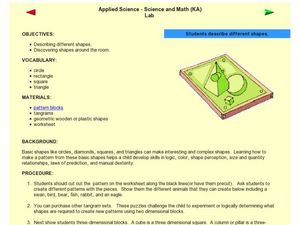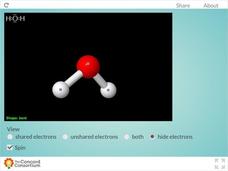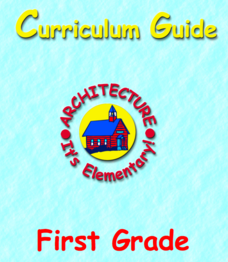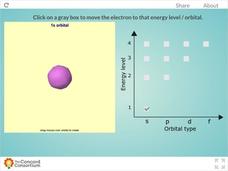Royal Society of Chemistry
Shapes of Molecules—Geometry of Central Atom
How is a molecule's shape determined? Explore bond angles, lone pairs, and VSEPR theory through a logic-based activity. Chemists pull together information about the major molecular shapes, then use it to solve puzzles.
Curated OER
Revise Identifying 3-D Shapes
In this 3-D shapes worksheet, students practice identifying 8 3-D shapes with their following precise names: cube, cuboid, square based pyramid, cone, cylinder, tetrahedron, octagonal prism and hexagonal prism.
Royal Society of Chemistry
Complex Ion Shapes
Things are really shaping up! Provide young chemists with polyatomic ion practice using an interesting interactive. Individuals complete puzzles focused on molecular geometry and complex ions.
PhET
Molecule Shapes
The shape of a molecule is determined by the arrangement of atoms around the central atom and lone pairs of electrons. Scholars build models of molecules using single, double, and triple bonds. They can then see real molecules bond...
Serendip
Diffusion and Cell Size and Shape
Is your class ready to size up the topic of diffusion? Help them get cell shape savvy with a well-written handout. The resource covers how substances such as oxygen passively move through the cell membrane and how cell size and shape...
Curated OER
Applied Science - Science and Math (K) Lab
In this shape instructional activity, learners cut out tangram shapes and create different pictures with them. They look at 3-D shapes as well. There is a nice, hands-on component built into this instructional activity.
Concord Consortium
Unshared Electrons and the "Bent" Shape
Why is water always so bent out of shape? Scholars investigate the molecular geometry of the water molecule using a 3-D resource. The interactive features options such as rotation and the ability to view electron pairs.
Curated OER
Shapes of Molecules
The VSEPR Model of molecular structure is exhibited through this series of slides. The step-by-step process is listed, and then examples are provided. The graphics give a visual display of the spatial relationship between the atoms of...
Cold Spring Harbor Laboratory
The DNA Molecule Is Shaped like a Twisted Ladder
One of the first models of DNA appeared to be a triple helix. Young scientists learn about the many scientists who worked to find the shape of DNA. They observe multiple models, tests, and experiments to understand the conclusions. An...
Curated OER
Applied Science - Science and Math Lab
Create three dimensional objects in an applied science lesson plan. The goal is for your class to recognize, compare, and model shapes. Using cookie cutters and clay or play dough, they create models for three-dimensional shapes.
Curated OER
Soft Sculpture Birds
Art can mimic life, and animals are always interesting subjects. Learners create large soft sculptures (stuffed) birds using paper, paint, and other basic collage materials. They view images of birds, and discuss bird traits and shapes....
Curated OER
Circles to Spheres
Students investigate circles and spheres. In this space shapes lesson, students compare and contrast two-dimensional and three-dimensional shapes. Students investigate the relationship between plane and space shapes.
Curated OER
Hurricane Shapes: Spatial Patterns on Satellite Images
In this earth science learning exercise, students match 21 hurricane satellite images to their appropriate shape. They also answer 4 short answer questions about hurricane shape classification.
American Institute of Architects
Architecture: It's Elementary!—First Grade
Build an interest and appreciation for architecture in your young learners with this fun 10-lesson art unit. Engaging children in using their five senses, the class first observes the environment around them, paying...
Space Awareness
What is a Constellation
Why do some stars in a constellation appear brighter than others? Using a get-up-and-move astronomy activity, scholars explore perspective and the appearance of constellations in the sky while developing an understanding of the...
Curated OER
Matters of Milk and Marshmallows
Students observe a teacher demonstration o classifying matter by its physical properties of shape and size. After discussing the definition of matter, students describe the state of matter. They sing a song to the tune of "Bingo." In...
Concord Consortium
Energy Levels of a Hydrogen Atom
Tired of blowing up countless balloons to illustrate orbital shapes around an atom? Give your lungs a break and use an interactive instead! Learners observe s, p, d, and f orbitals through the first four energy levels using hydrogen as a...
Concord Consortium
Electron Geometry
It's time to whip your chemistry class into shape! Begin your study of molecular geometry with a colorful, 3-D interactive. The resource shows models of linear, trigonal planar, and tetrahedral molecules.
Curated OER
VSEPR Theory: Predicting the 3-D Shapes of Molecules
In this VSEPR theory worksheet, students draw the Lewis structures for 5 molecules, they build the molecule, sketch the structure, show the bond angles and name the molecule. They also answer a question about the VSEPR theory and what...
Curated OER
Desert Shape Book
In this cactus worksheet, students cut out the cactus shape pattern and use it as part of their cover for a desert shape book. Students cut out 1 cactus.
DiscoverE
LIDAR: Mapping with Lasers
We would be lost without maps! How are they made? Introduce junior topographers to LIDAR technology with a fascinating activity. Set up a mock city, then have learners operate a laser measure to determine the shape of the landscape using...
Curated OER
Symmetry that is Basic and Beautiful
Learners explore lines of symmetry. In this symmetry lesson, students divide and combine shapes along basic lines of symmetry. Learners explore symmetry in real life objects.
Curated OER
Bubbles
Learners blow bubbles using various wands and observe the shape of the bubble. They design and construct new wands and then measure and illustrate the bubbles.
American Museum of Natural History
Thinking in the Three Dimensions
Discover different dimensions with paper folding. Pupils first read about zero, one, two, and three dimensions, and then learn about the fourth dimension, time. They then use origami to create models of shapes in three dimensions and use...
Other popular searches
- 3 D Geometric Shapes
- 3 D Shapes
- 2 D Shapes
- Geometry Shapes 3 D Shapes
- 3 D Shapes
- 2 D Shapes
- 3 D Geometric Shapes
- Kindergarten 3 D Shapes
- 3 D and 2 D Shapes
- 3 D Shapes Worksheet
- Cylinder 3 D Shapes
- Free 3 D Geometric Shapes





